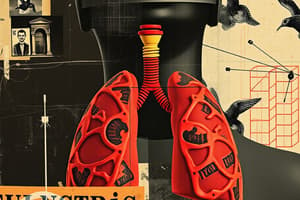Podcast
Questions and Answers
Which of the following fuels can produce carbon monoxide gas?
Which of the following fuels can produce carbon monoxide gas?
- Natural gas (correct)
- Solar energy
- Nuclear energy
- Wind power
What is the main reason why carbon monoxide is difficult to detect?
What is the main reason why carbon monoxide is difficult to detect?
- It is a tasteless gas
- It is a colorless gas
- It is an odorless gas (correct)
- It is a highly flammable gas
How does carbon monoxide affect the body when inhaled?
How does carbon monoxide affect the body when inhaled?
- It stimulates the production of red blood cells
- It binds to hemoglobin and prevents oxygen delivery (correct)
- It enhances the body's immune system
- It improves lung function
What are the initial symptoms of carbon monoxide poisoning?
What are the initial symptoms of carbon monoxide poisoning?
What can happen if a person is exposed to high concentrations of carbon monoxide?
What can happen if a person is exposed to high concentrations of carbon monoxide?
Which of the following is a potential source of carbon monoxide gas?
Which of the following is a potential source of carbon monoxide gas?
What happens when carbon monoxide is inhaled?
What happens when carbon monoxide is inhaled?
What are the initial symptoms of carbon monoxide poisoning?
What are the initial symptoms of carbon monoxide poisoning?
How does prolonged exposure to low levels of carbon monoxide affect the body?
How does prolonged exposure to low levels of carbon monoxide affect the body?
Why is carbon monoxide difficult to detect without specialized equipment?
Why is carbon monoxide difficult to detect without specialized equipment?
Flashcards are hidden until you start studying
Study Notes
Carbon Monoxide Production
- Fuels that burn incompletely, such as gasoline, wood, coal, and natural gas, produce carbon monoxide gas.
Detection Challenges
- Carbon monoxide is odorless and colorless, making it difficult to detect without specialized equipment.
Health Effects on the Body
- When inhaled, carbon monoxide binds to hemoglobin in red blood cells, reducing oxygen transport to organs and tissues.
Initial Symptoms of Poisoning
- Early signs of carbon monoxide poisoning include headache, dizziness, weakness, nausea, and confusion.
Risks of High Concentrations
- Exposure to high levels can lead to loss of consciousness, permanent brain damage, or death due to oxygen deprivation.
Potential Sources
- Common sources of carbon monoxide include faulty furnaces, vehicle exhaust, gas-powered generators, and stoves.
Inhalation Effects
- Inhaled carbon monoxide limits the blood’s ability to carry oxygen, leading to symptoms ranging from headaches to severe neurological damage.
Prolonged Low-Level Exposure
- Chronic exposure to low levels can cause long-term health issues, including cognitive impairment and cardiovascular problems.
Importance of Detection Equipment
- Specialized detectors are necessary because carbon monoxide's subtle effects and lack of sensory cues can easily go unnoticed, leading to dangerous situations.
Studying That Suits You
Use AI to generate personalized quizzes and flashcards to suit your learning preferences.




